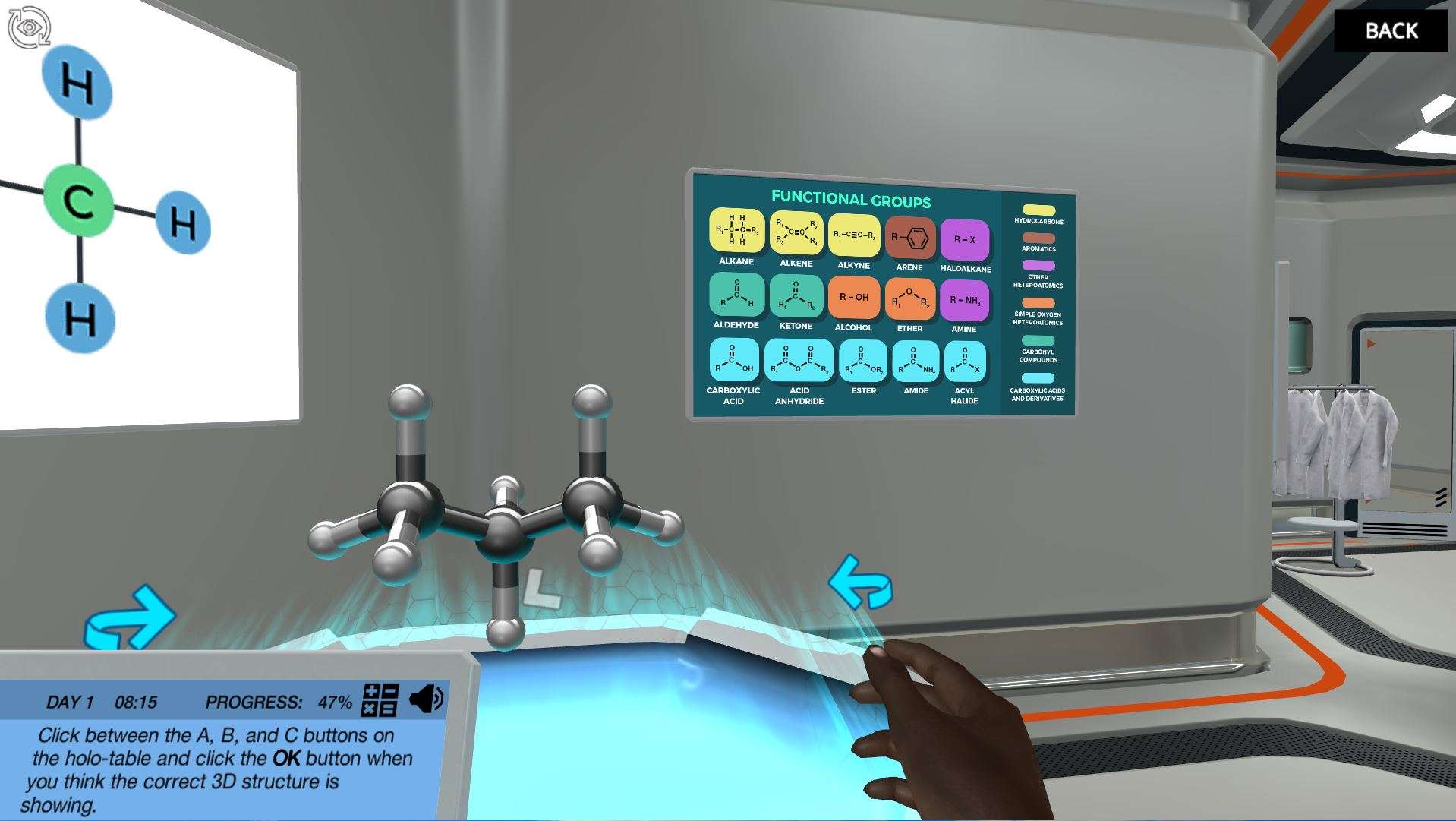Heading 1
Heading 2
Heading 3
Heading 4
Heading 5
Heading 6
Lorem ipsum dolor sit amet, consectetur adipiscing elit, sed do eiusmod tempor incididunt ut labore et dolore magna aliqua. Ut enim ad minim veniam, quis nostrud exercitation ullamco laboris nisi ut aliquip ex ea commodo consequat. Duis aute irure dolor in reprehenderit in voluptate velit esse cillum dolore eu fugiat nulla pariatur.
Block quote
Ordered list
- Item 1
- Item 2
- Item 3
Unordered list
- Item A
- Item B
- Item C
Bold text
Emphasis
Superscript
Subscript
About This Simulation
Join Dr. One on a mission to figure out how to systematically name hydrocarbons and interpret and use the various core formula types for organic compounds.
Learning Objectives
- Apply the nomenclature of simple hydrocarbons to given 2D and 3D structures
- Interpret the core formula types for organic compounds
- Decide the appropriate chemical formula type to use for a given hydrocarbon
About This Simulation
Lab Techniques
Related Standards
- HS-PS1-3, HS-PS1-6
- Unit 2: Ionic Compounds Structure and Properties
- 10.1 Fundamentals of organic chemistry
- 10.2 Functional group chemistry
- 20.1 Types of organic reactions
Learn More About This Simulation
This simulation was adapted from the original, longer “Organic Chemistry Introduction” simulation. See the full-length simulation for more information.
What’s in a name? In this simulation, you will learn how to name the hydrocarbons - the core part of organic compounds. You will also be challenged with various ways of representing chemical structures in 2D, and learn to decide when to use which one.
Organic chemical compounds
You will start off by meeting with Simon, who’s having trouble figuring out the ins and outs of the fundamentals within organic chemistry. He’s especially lost on how the naming works - which is known as the nomenclature. Perhaps you will be able to sort him out?
Match 2D structure with name and 3D visualization
In the lab, you join forces with Dr. One, who will support and test you on your mission. Begin by suiting up for the lab and getting a quick briefing on how the nomenclature works for hydrocarbons. Then dive straight in to the challenge of figuring out the appropriate name for a given 2D structure, helped by 3D molecular visualization on your holotable.
A chemical formula type for every need
In the challenge above, you’ll be exposed to a specific type of 2D representation of molecules. There are several other types of these representations, though; also called formula. Which one is appropriate to use when? You will explore this on the lab’s interactive wall screen, where you need to assess the strengths and weaknesses of the common types of formula.
Return to Simon
Armed with all your new knowledge, you will return to Simon to share all you’ve learnt. It’s a tricky topic though, but luckily you can repeat the experience if you want to drive the points in even further. Will you be able to solve the hydrocarbon nomenclature challenge?
RELATED SIMULATIONS
Organic Chemistry Introduction: Learn about organic compounds
Carbon Valence, Hybridization and Angles
Functional Groups and Basic Chemical Tests
For Science Programs Providing a Learning Advantage
Boost STEM Pass Rates
Boost Learning with Fun
75% of students show high engagement and improved grades with Labster
Discover Simulations That Match Your Syllabus
Easily bolster your learning objectives with relevant, interactive content
Place Students in the Shoes of Real Scientists
Practice a lab procedure or visualize theory through narrative-driven scenarios


FAQs
Find answers to frequently asked questions.
Heading 1
Heading 2
Heading 3
Heading 4
Heading 5
Heading 6
Lorem ipsum dolor sit amet, consectetur adipiscing elit, sed do eiusmod tempor incididunt ut labore et dolore magna aliqua. Ut enim ad minim veniam, quis nostrud exercitation ullamco laboris nisi ut aliquip ex ea commodo consequat. Duis aute irure dolor in reprehenderit in voluptate velit esse cillum dolore eu fugiat nulla pariatur.
Block quote
Ordered list
- Item 1
- Item 2
- Item 3
Unordered list
- Item A
- Item B
- Item C
Bold text
Emphasis
Superscript
Subscript
A Labster virtual lab is an interactive, multimedia assignment that students access right from their computers. Many Labster virtual labs prepare students for success in college by introducing foundational knowledge using multimedia visualizations that make it easier to understand complex concepts. Other Labster virtual labs prepare learners for careers in STEM labs by giving them realistic practice on lab techniques and procedures.
Labster’s virtual lab simulations are created by scientists and designed to maximize engagement and interactivity. Unlike watching a video or reading a textbook, Labster virtual labs are interactive. To make progress, students must think critically and solve a real-world problem. We believe that learning by doing makes STEM stick.
Yes, Labster is compatible with all major LMS (Learning Management Systems) including Blackboard, Canvas, D2L, Moodle, and many others. Students can access Labster like any other assignment. If your institution does not choose an LMS integration, students will log into Labster’s Course Manager once they have an account created. Your institution will decide which is the best access method.
Labster is available for purchase by instructors, faculty, and administrators at education institutions. Purchasing our starter package, Labster Explorer, can be done using a credit card if you are located in the USA, Canada, or Mexico. If you are outside of North America or are choosing a higher plan, please speak with a Labster sales representative. Compare plans.
Labster supports a wide range of STEM courses at the high school, college, and university level across fields in biology, chemistry, physics, and health sciences. You can identify topics for your courses by searching our Content Catalog.















